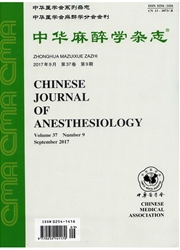

 中文摘要:
中文摘要:
目的探讨中脑导水管周围灰质(PAG)星形胶质细胞活化在大鼠神经病理性痛中的作用。方法雄性SD大鼠72只,体重200~250g,9周龄,采用随机数字表法分为5组:正常对照组(C组,n=8)、假手术组(S组,n=8)、神经病理性痛组(NP组,rb=32)、生理盐水对照组(NS组,n=12)和星形胶质细胞活化抑制剂氟代柠檬酸组(FC组,n=12)。NP组、NS组和FC组采用慢性坐骨神经缩窄性损伤(CCI)术制备大鼠神经病理性痛模型。FC组CCI术后14d时于PAG腹外侧核注射10pmol氟代柠檬酸0.5μl,NS组给予等容量生理盐水。C组和S组取8只大鼠,NP组分别于CCI术前、CCI术后3、7、14、21d时取8只大鼠,NS组和FC组取8只大鼠,分别于CCI术前、CCI术后14d给药前与给药后30、45、60、75、90、105min时测定机械痛阈。测定机械痛阈后,处死大鼠,取PAG,采用免疫荧光法测定星形胶质细胞标记物胶质纤维酸性蛋白(GFAP)表达,反映活化的星形胶质细胞计数。结果与C组比较,NP组CCI术后3、7、14、21d时机械痛阈降低,CCI术后7、14、21d时PAG活化的星形胶质细胞计数增加(P〈0.01),s组上述指标比较差异无统计学意义(P〉0.05);与NS组比较,Fc组给药后各时点机械痛阈升高,PAC活化的星形胶质细胞计数减少(P〈0.01)。结论中脑PAG星形胶质细胞活化参与了大鼠神经病理性痛的维持。
 英文摘要:
英文摘要:
Objective To investigate the role of astrocyte activation in the midbrain periaqueductal gray (PAG) in a rat model of neuropathic pain. Methods A total of 72 male Sprague-Dawley rats, aged 9 weeks, weighing 200-250 g, were randomly divided into 5 groups using a random number table: normal control group ( group C, n = 8) , sham operation group ( group S, n = 8), neuropathic pain group ( group NP, n= 32) , normal saline control group (group NS, n= 12) , and fluorocitrate (an astrocyte inhibitor) group (group FC, n= 12). Neuropathic pain was induced by chronic constriction injury (CCI) to the sciatic nerve in NP, NS and FC groups. In group FC, 10 pmol fluorocitrate 0.5 μl was injected into the nuclei of the ventrolateral PAG on day 14 after CCI, and the equal volume of normal saline was given instead in group NS. Eight rats in C and S groups, 8 rats before CCI, on days 3, 7, 14 and 21 after CCI in group NP, and 8 rats in NS and FC groups were selected, and the mechanical pain threshold was measured before CCI, on day 14 after CCI and at 30, 45, 60, 75, 90 and 105 min after administration. After measurement of the mechanical pain threshold, the rats were sacrificed, and the midbrain PAG was isolated for determination of the expression of astrocyte marker glial fibrillary acidic protein by immunofluorescence. Results Compared with group C, the mechanical pain threshold was significantly decreased on days 3, 7, 14 and 21 after CCI, the number of activated astrocytes in the PAG was significantly increased on days 7, 14 and 21 after CCI in group NP (P〈0.01) , and no significant change was found in the parameters mentioned above in group S (P〉0.05). Compared with group NS, the mechanical pain threshold at each time point after adiministration was significantly increased, and the number of activated astrocytes in the PAG was significantly decreased in group FC (P〈0.01). Conclusion Astrocyte activation in the midbrain PAG is involved in the maintenance of neuropathic pain
 同期刊论文项目
同期刊论文项目
 同项目期刊论文
同项目期刊论文
 期刊信息
期刊信息
